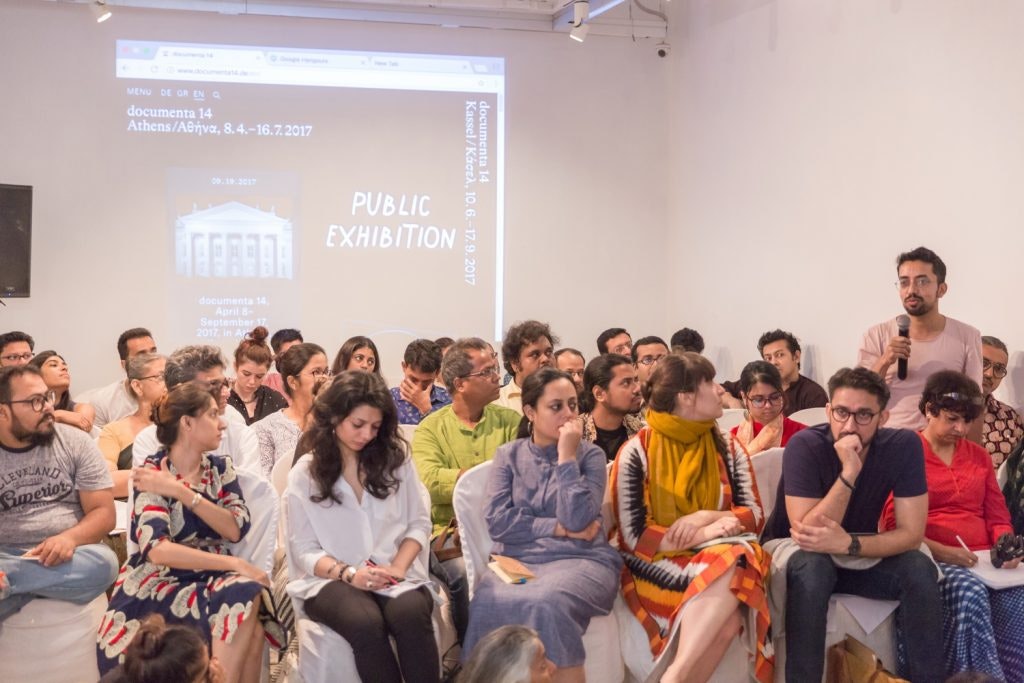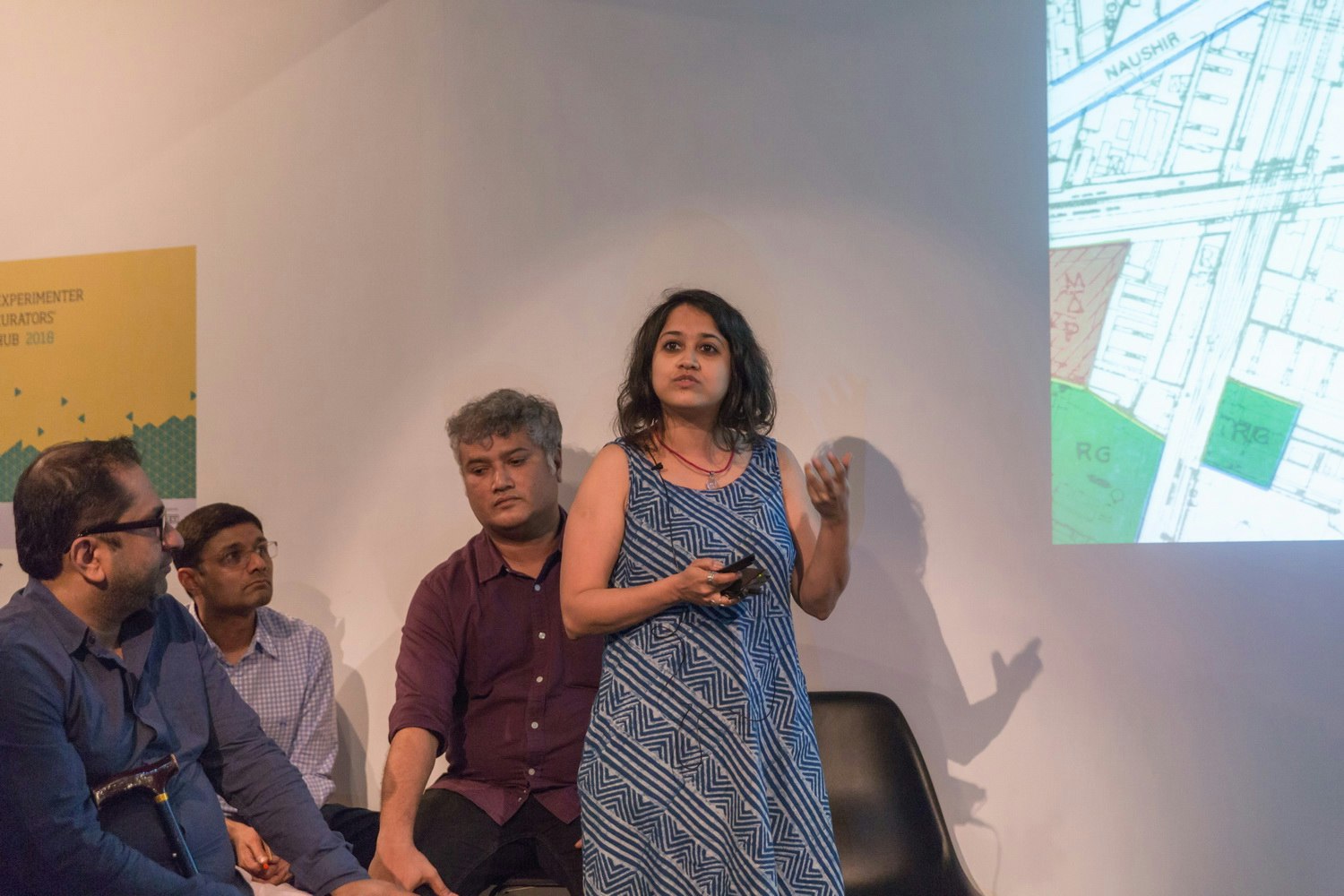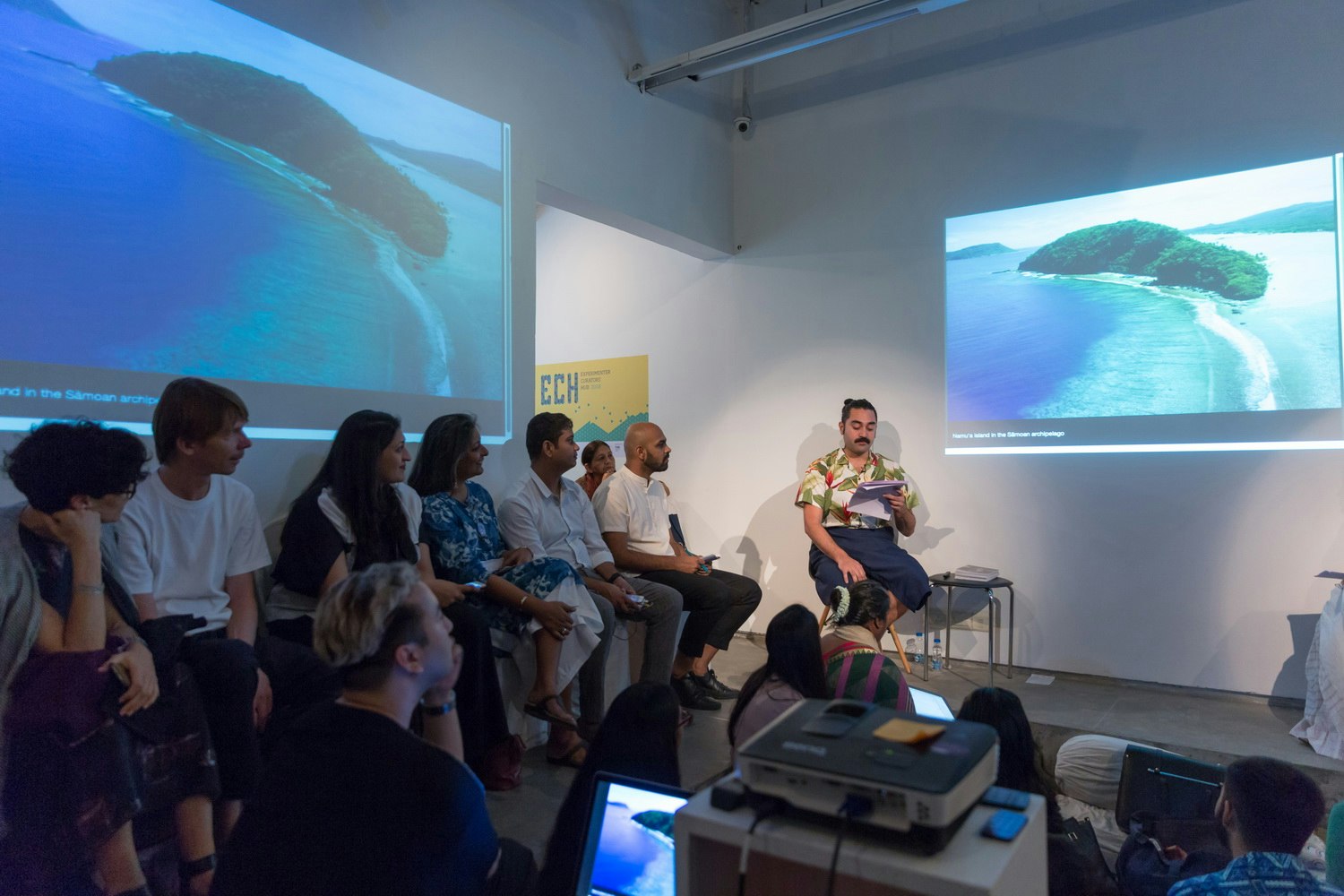Curating as resilience: in praise of opacity and incoherence
Meera Menezes

Audience at Experimenter Curators’ Hub 2018, Day 2, 27 July 2018; photo: Experimenter, Kolkata.
Ploughing the database
In a world bombarded by data, could the database offer us a new organising principle to make sense of the world? Taking his cue from Russian media theorist Lev Manovich, Sabih Ahmed, Researcher at Asia Art Archive (AAA), suggested at the Experimenter Curators’ Hub (ECH), in Kolkata that this might well be the case and accounted for the impulse to curate and archive almost everything in the present age. For Ahmed, a large part of his work digitising the archives of artists involves building databases. He talked about how his work and thinking processes at AAA fed into his role as a Curatorial Collegiate member of the 11th Shanghai Biennale. Dwelling on the methodology of the Biennale, he explained how it was not based on a theme but rather on questions, analyses and procedures. ‘What if particular impulses, particular methods, particular archives and trajectories of different practices were redeployed into curatorial propositions?,’ he asked. Ahmed took the personal archive of Ha Bik Chuen, a Hong Kong-based printmaker and sculptor with a secret passion for photo-documenting, and redeployed it ‘to explore the changing optic of the archive in the 21st century.’ His biggest inference from the exercise was that curation was not so much about decoding the world and its art as much as about recoding it.
Ahmed’s presentation generated a number of questions among members of the audience that revolved around the possibility of hacking the database, the distinction between curating and archiving, as well as the trickier question of how to curate an archive. More pertinently, historian Jahnavi Phalkey, founding Director of the Science Gallery Bengaluru, interrogated the use of the archive to institutionalise an expanded field like art, when historians were in fact moving out of the archive.
This lively exchange of divergent points of views in an atmosphere of conviviality has been intrinsic to the ethos of the annual ECH, as its co-organiser, Prateek Raja, pointed out. As co-founder, with Priyanka Raja, of Experimenter, in his opening remarks he also drew attention to how Kolkata, traditionally known for its stirring debates and spirit of argumentation, was ideally positioned to host the annual ECH. As in previous years, the ECH was moderated by independent curator Natasha Ginwala and offered both Indian and international curators the opportunity to talk about their projects and extend the discourse around curatorial practice and exhibition-making over three intense days from 26–28 July 2018. This year, thanks to the partnership with the Sharjah Art Foundation, audiences in Sharjah—who watched the proceedings via live stream—could also interact with those in Kolkata.

Sabih Ahmed, Experimenter Curators’ Hub, Day 1, 26 July 2018; photo: Experimenter, Kolkata.
Themes that Sabih Ahmed touched on, such as big data, data visualisation and recoding, also found resonances in Jeebesh Bagchi’s presentation. A member of the Raqs Media Collective, Bagchi began his talk by invoking more down to earth metaphors. He stated that curatorial practice was akin to ploughing, while the artistic practice was similar to planting. Bagchi revealed that in the run up to the 11th Shanghai Biennale in 2016, of which Raqs were the curators, the trio came up with a new term ‘Algebrahmins’, referring to people who were masters in transforming qualia into quantities. In a world where enormous amounts of data were being generated, Bagchi put forth the view that the curatorial work lay precisely in finding these displaced qualias or images. The Biennale’s curatorial team also eschewed the idea of themes, something Ahmed had touched upon earlier, and decided to work with the idea of a source instead. Raqs sent the Bengali filmmaker Ritwik Ghatak’s 1974 film Jukti, Takko aar Gappo (Reason, Debate and a Story) to the participating artists with a short note, hoping this would serve as a conceptual peg to produce other stories, which in turn could overlay each other.

Erin Gleeson, Experimenter Curators’ Hub 2018, Day 1, 26 July 2018; photo: Experimenter, Kolkata.
The topic of the archive also figured prominently in Erin Gleeson’s presentation. Gleeson is an independent curator, researcher and writer who has been based in Phnom Penh since 2002. With a keen interest in exhibition histories, she highlighted how the absence of an archive was a constant presence she identified when she began her work in Cambodia. Given that citation—which is based on accumulated experiential knowledge—is key to curatorial practice, what happens when knowledge is written by the colonisers, and when so much of it is housed in France as in the case of Cambodia? Gleeson noted that Cambodian artists themselves were keen to counter this colonial and tourist archive and she articulated some of the strategies that were employed to do so. These included FIELDS: An Itinerant Inquiry Across the Kingdom of Cambodia, a triennial roving residency in Cambodia, which she co-founded with Vera Mey, from 2011–2018, as well as her work as the co-founding director of SA SA BASSAC, a non-profit exhibition space, reading room and resource centre in Phnom Penh.
Hospitality and queerness
The second day’s proceedings at the ECH were kicked off by Adam Szymczyk, Artistic Director of documenta 14. It was Szymczyk’s second visit to the Hub, having presented at Experimenter in 2014 in the run up to the European quinquennial. This time, his visit was to take stock, talk about outreach, and the immaterial residue and effects of such an exhibition. Szymczyk emphasised that ‘learning’, taken from documenta 14’s working title Learning from Athens, was employed in its gerund form as it allowed for becoming ‘a locus of confluences.’ In his vision there was also a conscious effort to move beyond exhibition spaces as evident in the involvement with Greek public TV alongside the radio stations organised by Bonaventure Soh Bejeng Ndikung—another presenter at the 2018 ECH. Szymczyk highlighted documenta 14’s engagement with magazines, citing South as a State of Mind, and spoke about how institutions such as the Athens Conservatory have adopted an interdisciplinary approach in dialogue with contemporary art. In the question and answer session that ensued, a member of the audience provoked Szymczyk into responding to the issue of such mega exhibitions inducing a sense of exhaustion. He remarked that visitors were not expected to see everything that was on offer, adding that the exhibition was exhausting by design and meant to counter an ‘expectation of totality.’

Adam Szymczyk, Experimenter Curators’ Hub 2018, Day 2, 27 July 2018; photo: Experimenter, Kolkata.
A Thousand Worlds: Curating as a Form of Resilience was the title of Berlin-based curator Övül Ö. Durmusoglu’s presentation. Drawing on the French writer, poet, philosopher and literary critic Eduard Glissant (1928–2011), she advocated the need to aspire to opacity and the refusal of the demands of a world, which increasingly requires transparency, and by extension, control. This formed the context for four of her projects: YAMA, a public screen project on top of a hotel in Istanbul in 2016 (that was later shut down due to political pressure); a twenty-year anniversary exhibition of Kaos GL, the first LGBTI association in Istanbul; a retrospective of Turkish artist Gulsun Karamustafa in Berlin; and a city-wide contemporary arts festival, Sofia Contemporary 2013.

Övül Ö. Durmusoglu (left) with Natasha Ginwala (right), Experimenter Curators’ Hub 2018, Day 2, 27 July 2018; photo: Experimenter, Kolkata.
Durmusoglu was followed by Bonaventure Soh Bejeng Ndikung via Skype, who used the sonic as a point of departure to talk about his projects. His preoccupation with decolonisation and his quest for other sources of knowledge led him to trace the trajectory of the Egyptian-American musician Halim El-Dabh (1921–2017). El-Dabh, who was a pioneer of electronic music and whose works include The Expression of Zaar (1944) and The Dog Done Gone Deaf (2007), had been unfairly overlooked in several dictionaries of music for the twentieth-century. Bonaventure was keen to make El-Dabh’s contributions as a musician, as well as others such as the American Julius Eastman (1940–1990), visible. In his discussion with ECH moderator Natasha Ginwala he also touched upon his project space SAVVY Contemporary in Berlin, and his projects around corpoliteracy and ‘hostipitality’ (a combination of hostility and hospitality). These in turn were instrumental in bringing certain methodologies to Berlin, which were now being adopted by some of the city’s model institutions. However, given the long history of non-referencing and erasure, Bonaventure sounded a cautionary note against these establishments usurping one’s practice.
Mumbai-based urbanists Prasad Shetty and Rupali Gupte, the last speakers to present on the second day of the ECH, drew the audience’s attention to how cities were not ‘densifying’ but ‘intensifying.’ By this they meant that the movement within cities was increasing exponentially due to the ‘emergence of autonomous, mobile and unpredictable work entities.’ Given their preoccupation with urban form, the duo was also interested in the blurred or corroded edges of working and living spaces, including the porosity of homes in chawls in Mumbai. They posited that cellurisation, which accompanied the resettlement of slum or chawl dwellers, had generated an urban form with hard impenetrable edges, leading in turn to fractured cities and societies. Their interest in the blurred edges in cities has also played out in their works Being Nicely Messy: A Proposition for the Future of Urban Mobility, shown in Istanbul in 2012, and Transactional Objects for the 56th Venice Biennale in 2015. Several members of the audience found Shetty and Gupte’s presentation problematic and asked if in their celebration of messiness and incoherence, they were glossing over the hardships of people living in Mumbai, a critique that certainly had its merits.

Prasad Shetty (centre, seated) and Rupali Gupte (standing), Experimenter Curators’ Hub 2018, Day 3, 28 July 2018; photo: Experimenter, Kolkata.
Restaging fragments
On the third and final day of the ECH, art historian Kavita Singh prefaced her presentation with a nod to Erin Gleeson’s talk, remarking that in contrast to how curators and artists in Cambodia came together to force into existence an infrastructure, she would talk about the exact opposite. The focus of her attention was India’s National Museum in Delhi, and she posed the simple question about why it couldn’t do what it was meant to do. In her engaging and animated talk, Singh cited two exhibitions to bring up a plethora of problems that curators faced when working with the institution. The first was India and the World: A History in Nine Stories (2017), a joint exhibition with the British Museum, where the Indian curator, Naman Ahuja, was practically written out of the Delhi leg of the show. Singh also highlighted her co-curatorial project (with fellow art historian Preeti Bahadur) for the National Museum in 2015, Nauras: The Many Arts of the Deccan, and the complete lack of guidelines and trained staff to help with the hanging of the show. In the discussion that followed her presentation, filmmaker and artist Ashish Avikunthak talked about how right-wing politics were colouring institutions such as the National Museum leading to censorship, which reflected in the exclusion of certain art works from India and the World. Szymczyk bemoaned the demise of democratic institutions, which have become ‘passionless’ and ‘incompetent’ the world over, while Jahnavi Phalkey asked us to consider doing history in other ways, revitalising other spaces to reclaim our past.

Léuli Eshrāghi, Experimenter Curators’ Hub 2018, Day 3, 28 July 2018; photo: Experimenter, Kolkata.
Kavita Singh was followed by indigenous curator and artist Léuli Eshrāghi, who hails from the Sāmoan villages of Āpia, Leulumoega, Siʻumu, Salelologa, and other ancestries. He set the tone for his presentation, Languaging and Critical Care, by stating, ‘I acknowledge the violence of English monolingual presence globally on all our distinct languages and ways of knowing and being, and varied states of language distress here and elsewhere that can only be remedied by more care across communities.’Eshrāghi went on to speak about his projects focused on agana or language, sauniga or ceremony, and ʻogānuʻu ʻo fāʻaliga or display territories. He also talked at length about the rampant exploitation of land and resources by colonial settlers and the displacement of indigenous peoples. While Eshrāghi’s statements about the underrepresentation of heterogeneous, indigenous practices and their stereotyping in Australian art spaces certainly rang true, by belabouring the point his argument was less evocative and nuanced than it might otherwise have been.
The last speaker of the day was writer, thinker and cultural critic Shumon Basar who joined from Sharjah via Skype. Basar is the Commissioner of the annual transdisciplinary summit Global Art Forum in Dubai, which he positioned as ‘a live content machine.’ While previous editions of the Forum have revolved around media, history and trade, most recently the ‘perils and potential of automation ’ have held centrestage. Basar pointed out that machines were constantly talking behind one’s back and that though there is the fear of automation rendering us redundant, we have in reality been cyborgs for a long time. He, however, cautioned against leaving things to the technologists and pleaded instead for the need for writers and thinkers. Basar also took up the issue of data, which had earlier figured in Ahmed’s and Bagchi’s presentations, pertinently reminding us that as everything turns into data, power becomes less visible.

Prateek Raja (left, standing), co-founder of Experimenter, with panel of participating curators, Experimenter Curators’ Hub 2018, Day 3, 28 July 2018; photo: Experimenter, Kolkata.
At the end of the final day, in keeping with the Hub’s tradition, all the curators gathered in the well of the house to field a series of questions posed by Ginwala and the audience. These ranged from the strategies curators used to restage fragments, the role of institutions such as Reyum in Cambodia and Sarai in India, the lineage of documenta, museum protocols and the network of non-indigenous artists. A sombre note was struck by Singh who reminded the audience of dictatorships gaining ground both to the East and West of the subcontinent, as Gleeson’s presentation had amply demonstrated and the ‘need to start girding our loins’ given the atmosphere of self-censorship and a vitiated social media space in India. With the resurgence of right wing parties and populist policies the world over, in tandem with the proliferation of fake news and data mining, could strategies of opacity and incoherence, as alluded to in Durmusoglu and Bagchi’s presentations, perhaps provide vital spaces of resistance?
Experimenter Curators’ Hub (ECH) 8th edition was produced and presented by Experimenter, Kolkata, India, from 26–28 July 2018. The participating curators at ECH 2018 are documenta 14, 2017 Artistic Director, Adam Szymczyk; Curator at Shanghai Biennale 2016, Jeebesh Bagchi; Founding director of SAVVY Contemporary Berlin, Bonaventure Soh Bejeng Ndikung; and Cultural Critic and Commissioner of Global Art Forum, Shumon Basar. Completing this year’s revered group are independent curator Erin Gleeson; Urbanists Prasad Shetty and Rupali Gupte; Professor of Art and Aesthetics at JNU, Delhi, Kavita Singh; Researcher at Asia Art Archive, Sabih Ahmed; Curator at the Institute of Modern Art in Mi- anjin, Léuli Eshraghi; Curator at Hamburger Bahnhof, Berlin, Övül Ö. Durmusoglu. The hub is mod- erated by curator, researcher, and writer, Natasha Ginwala.
About the contributor
Meera Menezes is the Delhi correspondent of Art India and a regular contributor to Artforum.
